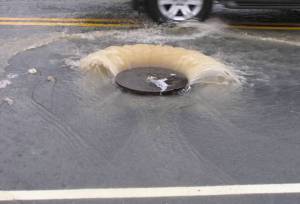There have been 99 documented sewage spills in Westchester since 2010…and still counting.
If you’re like most people on a municipal sewage system, you flush your toilet, you run your shower, and you assume that all that wastewater makes its way to your local sewage treatment plant to be fully treated before it is discharged to the nearest waterway. And when you hear about sewage contamination in our rivers and at our beaches, you figure your sewage treatment plant has failed to treat that waste properly. But that is often not the case.
Before our wastewater arrives at a sewage treatment plant, it travels through miles of pipes (starting with the one under your lawn or driveway), sometimes through pumping stations, and then through a pressurized sewer main. Different portions of this massive underground system of pipes have many different owners—towns, cities, counties and private property owners—and sections of it are in desperate need of repair. You can read about the scope of the problem, and some efforts to address it, in this recent Mamaroneck Review article.
Disrepair in the collection system means that wastewater containing raw sewage and household chemicals leaks—and sometimes bursts—out before it ever reaches a treatment plant, spilling into waterways where it harms the environment and makes people sick.
Thanks to increased federal and state government transparency, we can now find out where and when sewage is discharging from the collection system into our waterways and we can do something about it!
Save the Sound has assembled data from government databases on the reported sewage overflows in the Long Island Sound watershed in Westchester County since 2010 and created this map showing their locations. For more information on overflows, please click here.

Chronic Sewage Overflows Harm the Environment and Human Health
There have been over 99 government-documented sewage spills in Westchester County over the last five years. That’s approximately one reported spill every three weeks, and we know of many more that have gone unreported. Many of the spills are in the shore towns where the raw sewage can reach beaches and other sites where people come in contact with the water, posing a host of health threats. (Exposure to sewage contaminated water is particularly dangerous for children, the elderly and people with compromised immune systems.)
Overflowing untreated wastewater is also very harmful to wildlife and the environment. It contains high levels of nitrogen which causes algal blooms that rob oxygen from fish, lobsters, and all aquatic life which needs oxygen to survive. Our wastewater also includes detergents, pharmaceuticals, and a wide variety of chemicals that are harmful to animals, aquatic plants, and the ecosystem.
Wet Weather Overflows & Partial Treatment at Sewage Plants
In some places this pollution comes in a steady seep and in others it comes in large bursts. The bursts are caused by breakdowns in aging and poorly maintained pipes and pumps that crack or fail. Bursts of sewage often happen when it rains and stormwater and/or groundwater enter cracked pipes and overwhelm the system with too much water volume, pushing a mix of clean and dirty water out. This causes overflowing manholes and leaking lines.


The inundation of rain into the collection system can also cause too much water to reach sewage treatment plants, overwhelming the system and resulting in “partially treated wet weather bypasses.” This is so common that such bypasses are actually built into the operating permits for treatment plants! As a result, we are polluting our waterways and spending money and energy unnecessarily cleaning rainwater which should be left to soak into the ground to feed trees and plants, rather than getting into pipes.
How did we get here?
Back in the 1970s, when most of the municipal sewage infrastructure in Westchester was built, and for the following decade, the federal government provided the funding needed to build, maintain and update these systems. Since that time, with the shrinking of federal aid to states, that source of funding has fallen dramatically and a new source has not been established to address the gap.
As a result, New York State is now facing a substantial funding shortfall for water infrastructure and many plants and lines are operating well beyond their design life. With this critical aspect of our infrastructure underground and unseen, it often loses out to roads and bridges when budget decisions are made.
What can we do about it?
Keeping our sewage in the pipes is a very achievable goal and should be the expected minimum standard for all our communities. Getting our water infrastructure back in good working order and keeping it that way requires action and investment.
Save the Sound has taken a multi-tiered approach to this problem which includes public education, water quality testing, and lobbying for funding and strong regulations. Most recently, we have taken legal action in Westchester to bring all the stakeholders together to arrive at a unified, enforceable plan.
Citizens can take the following steps:
- Conserve water to reduce wear and tear on the system
- Inspect and repair the sewer line on your property—a professional video inspection will let you know if your line is cracked and contributing to the problem
- Disconnect home sump pumps and storm drains from the sewer lines. Rainwater and groundwater should be directed onto your lawn or into a rain garden; if flooding is a problem it should be directed into a stormwater drain, not the sewer lines
- Support local investment in infrastructure repair and upgrades
- Support green infrastructure projects like rain gardens and permeable pavement that can help stormwater soak into the ground
We hope you will also become a Save the Sound member and support our work on this effort. Stay tuned for future developments!
